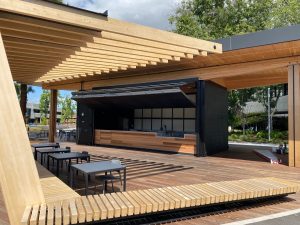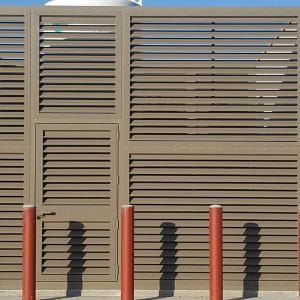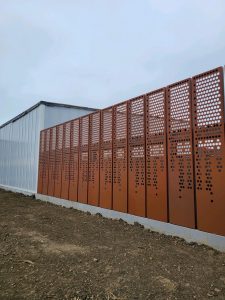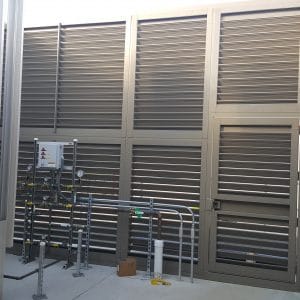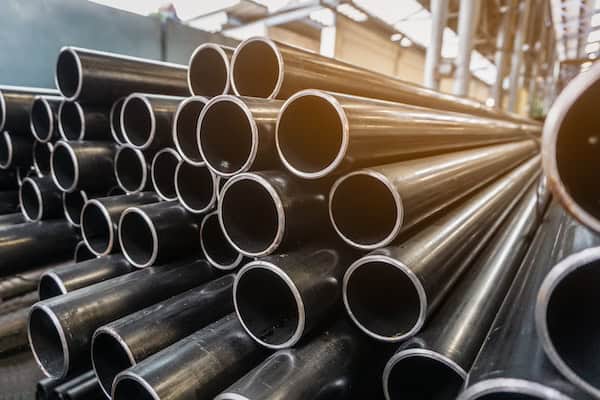Seeing Through the Options: Louvered vs. Perforated Screen Systems
When architects and designers seek to blend functionality with aesthetics, screening systems become invaluable tools. Offering solutions for privacy, ventilation, light control, and visual appeal, these systems are a cornerstone of modern building design. Among the popular choices are louvered and perforated screen systems. While both achieve similar goals, their design, functionality, and visual impact differ significantly. Let’s delve into the key distinctions between these two versatile architectural elements.
Louvered Screen Systems: The Art of Angled Control
Imagine a series of horizontal or vertical blades, precisely angled like Venetian blinds. That’s the essence of a louvered screen system. These blades, or louvers, can be fixed or adjustable, offering a dynamic approach to managing the environment.
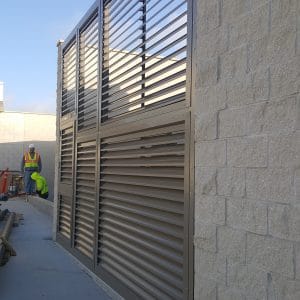 Key Characteristics of Louvered Screens:
Key Characteristics of Louvered Screens:
- Angled Blades: The defining feature, allowing for controlled airflow, light filtration, and varying degrees of privacy depending on the viewing angle and louver orientation.
- Adjustability (Optional): Many louvered systems offer adjustable blades, giving occupants the power to fine-tune light, ventilation, and privacy levels throughout the day. This adaptability is a significant advantage.
- Directional Control: Louvers excel at directing airflow and channeling views. By carefully orienting the blades, designers can optimize natural ventilation and frame specific vistas while obscuring others.
- Shadow Play: The angled nature of louvers creates distinct shadow patterns that can add architectural interest and dynamism to a building’s facade.
- Maintenance: Depending on the material and adjustability mechanism, louvered systems can require occasional cleaning and maintenance of moving parts.
- Visual Appearance: Louvered screens often present a strong linear aesthetic, with the repetition of the blades creating a sense of order and rhythm.
An example of a project involving louvers that Astro has worked on was for a health systems building. Astro worked very closely with the general contractor to develop this project from the architectural plans. After the initial concepts were developed, field measurements were taken and we then manufactured the louvered panels, door, and frame. These were manufactured from aluminum, and also engineered to withstand 53 PSF. All of these pieces then received a high-performance coating through a powder coat paint system to ensure smoothness and uniform coverage. The louvered walls and door allow for some light and air to flow into the space, and ensures the systems within stay protected and secure.
Perforated Screen Systems: The Beauty of Pattern and Light Diffusion
In contrast, perforated screen systems utilize panels with precisely punched or laser-cut openings. These perforations can range from simple geometric patterns to intricate artistic designs, offering a wide spectrum of visual and functional possibilities.
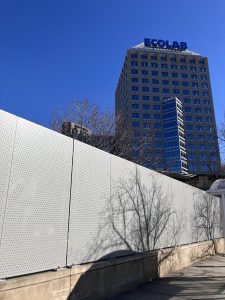 Key Characteristics of Perforated Screens:
Key Characteristics of Perforated Screens:
- Patterned Openings: The defining feature, allowing for diffused light, airflow, and a degree of visual permeability determined by the size, density, and pattern of the perforations.
- Fixed Openings: Unlike adjustable louvers, the openings in perforated screens are fixed. The level of light, ventilation, and privacy is determined by the chosen perforation design.
- Light Diffusion: Perforations tend to diffuse light more evenly, creating softer shadows and reducing harsh glare.
- Visual Texture: The variety of perforation patterns offers a vast range of visual textures, from subtle and understated to bold and statement-making. Custom perforation designs can even incorporate branding elements or artistic motifs.
- Lower Maintenance: With no moving parts, perforated screens generally require less maintenance than adjustable louvered systems, primarily focusing on cleaning the panel surfaces.
- Visual Appearance: Perforated screens can offer a more varied aesthetic depending on the chosen pattern, ranging from a subtle, almost transparent effect to a solid-looking surface with intricate details upon closer inspection.
The Nova Privacy Screen for Ecolab is one project Astro has recently worked on to create a permanent and visually pleasing screen. The Nova Privacy Screen creates a visual barrier and conceal items from sight while maintaining aesthetic appeal. Its punched pattern is customizable, allowing for tailored wind protection, privacy, and design needs.
After Astro engaged in collaborative discussions with our design team, the customer selected our standard circle pattern with a 7.4% open area, punched on 1/8” aluminum panels on our TruPunch 5000. These panels were then powder coated with an AAMA 2604 finish in Arcadia Silver from PPG Powder Coating, ensuring durability and a sleek appearance.
Choosing the Right System: Key Considerations
The optimal choice between louvered and perforated screen systems depends on the specific project requirements and design goals:
- Control: If dynamic control over light, ventilation, and privacy is paramount, adjustable louvered systems are the clear winner.
- Privacy: Both systems can offer privacy, but louvered screens provide more direct control through blade adjustment and angle. Perforated screens offer a fixed level of visual permeability based on the perforation design.
- Ventilation: Both systems allow for airflow, but louvered screens offer more directional and potentially greater control over ventilation, especially with adjustable blades.
- Aesthetics: The desired visual impact plays a significant role. Louvered screens offer a strong linear aesthetic, while perforated screens provide a wider range of visual textures and design possibilities.
- Maintenance: Perforated screens generally require less maintenance due to the absence of moving parts.
- Cost: The cost can vary depending on the material, size, complexity, and adjustability of the system. Generally, simple fixed louvered or perforated panels might be more cost-effective than complex adjustable louvered systems or highly intricate custom perforated designs.
Louvered and perforated screen systems are both powerful architectural tools, each offering unique advantages. Louvered screens excel in providing dynamic control over light, ventilation, and privacy through their adjustable blades. Perforated screens offer a diverse range of visual textures and light diffusion through their patterned openings, often with lower maintenance requirements.
Understanding these key differences allows architects and designers to make informed decisions, selecting the screen system that best aligns with their project’s functional needs and aesthetic vision, ultimately enhancing the built environment with both beauty and practicality.
Considering a screen system for your next project? At Astro Metal Craft, we specialize in crafting high-quality, custom metal screen solutions, including both louvered and perforated designs. Contact us today to discuss your project needs and explore the possibilities!


